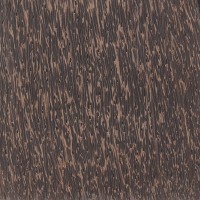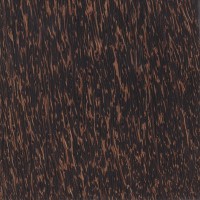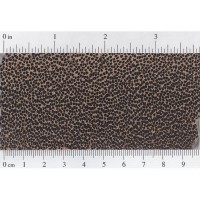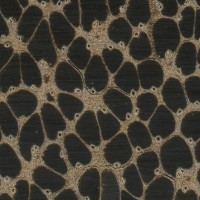 |
Common Name(s): Black Palm, Palmyra Palm Scientific Name: Borassus flabellifer Distribution: Tropical Asia and Africa Tree Size: 65-100 ft (20-30 m) tall, 2-3 ft (.6-1 m) trunk diameter Average Dried Weight: 61 lbs/ft3 (970 kg/m3) Specific Gravity (Basic, 12% MC): .79, .97 Janka Hardness: 2,020 lbf (9,000 N) Modulus of Rupture: 19,950 lbf/in2 (137.6 MPa) Elastic Modulus: 2,262,000 lbf/in2 (15.60 GPa) Crushing Strength: 10,190 lbf/in2 (70.3 MPa) Shrinkage: Radial: ~5.5%, Tangential: ~5.5%, Volumetric: ~11.0%, T/R Ratio: ~1.0 (Weight and hardness is for the higher-grade outer material, not the inner material.) |
Color/Appearance: Black fibers embedded in a lighter tan or light brown colored body. Fibers are more densely packed toward the outside of the tree trunk, becoming more and more sparse toward the center of the tree. The center core of the tree is soft and contains none of the darker vascular bundles that give the wood its characteristic look and hardness. (This is nearly opposite of the typical outer sapwood/inner heartwood combination found in dicot hardwoods.)
Grain/Texture: Black Palm has a medium to fine texture, though it is by no means even or uniform on account of the contrast between the dense, darker fibers, and the soft, lighter cellulose structure of the wood. Grain is very straight, and contains no growth rings, knots, or defects.
Endgrain: Being a monocot, endgrain characteristics are non-typical when compared to more familiar hardwood dicots. Black Palm has a uniform distribution of black fibers embedded in a softer yellow/brown body of parenchyma. Growth rings, sapwood, and rays are completely absent. Endgrain exhibits a dotted pattern unique to palm trees.
Rot Resistance: Black Palm is reported to be durable regarding decay resistance, though it is susceptible to insect attacks.
Workability: Tends to be quite difficult to work with both machine and hand tools. The hard fibers contrast with the soft body of the wood, and can be brittle and splinter or pull out. Very sharp tools and correct cutting angles are required to get clean results. Applying a hardener or sanding sealer prior to final sanding/machining may help give a more homogenous density and reduce tearout. The lighter colored body of the wood tends to absorb larger quantities of finish, so care must be taken during finishing; a sanding sealer is recommended.
Odor: No characteristic odor.
Allergies/Toxicity: Palms in the Arecaceae family have been reported to cause skin irritation, and general constitutional effects. See the articles Wood Allergies and Toxicity and Wood Dust Safety for more information.
Pricing/Availability: Although Black Palm trees can get up to several feet across, the center of the trunk is filled with a soft, unfigured portion, with only the outer areas of the trunk containing the characteristic colored fibers, so only narrow boards and spindle-stock are normally available. Prices for most sizes of Black Palm should be in the moderate range for an imported tropical wood.
Sustainability: This wood species is not listed in the CITES Appendices or on the IUCN Red List of Threatened Species.
Common Uses: Flooring, boatbuilding, walking sticks, knife and tool handles, rafters, furniture, and turned objects.
Comments: Technically neither a softwood nor a hardwood, palm falls into the category of monocots, which also includes bamboo, grass, banana, rice, wheat, corn, etc. (Monocot is short for monocotyledon, which simply means that the seed of the plant contains one leaf, rather than two as found in dicots.) Palm woods have no growth rings, and as a result, the shrinkage rate for drying the wood is more or less uniform between the radial and tangential surfaces, resulting in a T/R ratio of 1.0 and good dimensional stability.
Black Palm is highly variable in weight, strength, and hardness properties because the wood is so non-homogenous: the trunk is a gradient between the strong fibrovascular bundles, and the softer cellulose structure. Toward the outer wall of the trunk, the density of the wood is the greatest, and gradually becomes lighter, softer, and weaker towards the soft core. Because of this great variability, the density of Black Palm can range from less than 25 lbs/ft3 (400 kg/m3), to over 62 lbs/ft3 (1000 kg/m3)—where it will actually sink in water. A quick visual inspection of prospective wood blanks can help screen out undesired pieces: darker wood usually has a denser packing of fibers, and tends to produce heavier, stronger, and harder material.
Arecaceae family:
Scans/Pictures: Pictured below is an example of a rather dense and tightly packed specimen whose weight was approximately 68 lbs/ft3 (1090 kg/m3).
 |
 |
 |
 |





You have to take small cuts and sand to shape. One woodturner called it Porcupine Wood. I found out why hahaha!
The saw dust smells strongly of chocolate and it’s super super powdery, I’m making a 10’x3′ desk with it and it’s gonna be super heavy. Looks beautiful though
Greetings to everyone,
This tree is really hard to work, everyone says the same thing. Do you think the tree in the photo is a black palm?
It definitely looks like black palm to me. I wonder if there’s some sort of resin impregnation process happening here.
There is no impregnation process. It is one of the most difficult woods to work with (for rosaries). On the lathe, fine sanding and a little polish are used.
Black palm is called ‘Kaong’ in the Tagalog language of the Philippines. More commonly used for the fruit which are preserved and sold internationally as ‘Kaong’ and heart of palm called ‘Ubod’.
The outer wood is usually used for tool handles and the native tribes makes excellent 150+ fps-hunting bows from them.
Black palm is indigenous to South East Asia and should not be confused with similar looking Caribbean palms like peach palm or the like.
I think there is also a related species called Nibong palm and the Mentawai also use them to make bows from. I have some blanks that I plan to make a bow from, both nibong palm and arenga sugar palm like you mentioned.
I Did not have good luck with using black palm wood for my knife scales. It tends to chip too easily. I tried peening one of the pins in and the hole cracked. It’s just not that strong. It’s an interesting looking wood and I thought it would be pretty for a knife handle, but for me it was too difficult to work. So many others woods to choose from that are more stable and workable. I’ve used Bolivian Rosewood, Olive wood, Jobillo wood, Orange Osage, Blood wood, Vermillion and Purple Heart. All nice to use.
Good to note about the splitting risk. I agree that the wood definitely requires special handling/treatment. I’ve never used the wood for knife scales, but one thing that I’ve found helpful is to saturate areas of potential higher stress with thin CA glue prior to working to help reinforce the fibers.
I’m curious which way you had the grain for those handles. It would be striking to have the endgrain, but I could see it chipping easily. If the grain ran with the handle then maybe it would be more durable?
My grandfather had a knifehandle made from black palm. He made it himself and placed the pin inexpertly and it still held. I have more skill with wood than he did and i now believe that it only held because the grain of the wood went with the knife. Also: i agree that having the endgrain upwards would be stunning but i use black palm a lot and you can only do this with very big projects otherwise it will split. For smaller projects like knifehandles I always go with the grain because it simply doesn’t split. So to answer… Read more »
A turned bowl from black palm wood
It turns fine, but you’ve gotta sand in your shape, not cut it in. It does absorb finishes oddly, so be prepared for lots of initial coats, even with sealer. Here’s an old 1960’s automatic twist screwdriver that made a new handle for
I was born in Peru and every summer we went to the Ampiyacu River (a tributary of the Amazon) to live. The native homes on stilts are built with floors and walls of pona. Since it comes from to outer bark of a palm tree, when you flatten it, it has lots of cracks in it, which means that when you sweep the floors, dirt just can be swept into the cracks snd fall to the ground below. But the cracks in the walls mean skeeters come through and curious eyes can easily see through (the indigenous people loved to… Read more »
Could this vase be made of black palm? I haven’t been able to figure out the type of wood or where the design originates.
Yes, it looks like a palm wood. Though to me, it’s closer to the red palm type than black.
Thank you.
Has anyone used Black Palm for knife scales? If so, was stabilization necessary and what recipe was used to get a hard glossy finish?
Black Palm has a *great* tap-tone!, clear and almost bell-like, a bit like a tonal cross between wenge and granadillo. I used for a type of kalimba/mbira I make. I did the shaping by hand, carving it with heavier-weight X-Acto-type blades. Details are difficult because of the fracturing others have mentioned when cutting at all against the grain – it almost has to be “shaved” more than carved.
I can’t even imagine trying to turn it on a lathe….
Actually, with care it turns nicely. I have used it to great success to turn pens both as complete blanks, accent rings, and end cap finials where the end grain is the facing element – very beautiful.
You have to use really sharp tools and do a lot of sanding into the final shape.
I recently bought a piece of Palm Black and want to use it as a veneer on the head stock of an acoustic guitar I am building. Does anyone see any problem with that application?
Thanks, Lynn
I’ve not used black Palm myself but watching it be worked it appears quite splintery and likely to break when being cut into a thin veneer.
I just finished making my fifth project out of black palm wood – it i VERY – VERY splintery and nearly impossible to get totally smooth.
Here’s a harp with black palm sandwiched between caramelized curly maple. I use it for strength (1,870 pounds of tension on the strings) in the pillar and neck and below the soundboard. The dark stuff on the soundboard is burl walnut so don’t confuse it with the palm. Go to vavraharp.com for more pics.
THIS WOOD IS VERY HARD AND HAS BEAUTIFUL GRAIN. I TURN IT AND MAKE DRUM SHELLS.
So is this a solid trunk that you’ve hollowed out? Seems like that would be the perfect use for palm, since the center is much softer anyway, and the best material is out on the edges of the trunk.
Does anyone out there know what, if any fruit Black Palm produces? Coconut Palm (Coco in Philippines) is more of a tan – light brown, is this just a variation of “Black” Palm or is it independent bearing different fruit?
I could be wrong, but I don’t think there’s much of a correlation between fruit and the wood that any given palm tree will produce. Coconut Palm is not a variation of Black Palm, it’s considered a Red Palm: https://www.wood-database.com/red-palm/
Thank you for your reply. I am making a set of wood pens for a friend who is big into cooking and healthy foods. We decided to go with food related woods for the project. I just happen to have Black, Red, and apparently another shade of “Red” (Coco) on hand.
Essentially I am trying to decide if these variations of Palm are too much of the same thing, when there are so many other fruit bearing trees, bushes…
I went thru Jungle Operations School in Panama. All I or anyone else who has been thru it will say about Black Palms is they hurt like all get out if you walk into one at night or if you sit down without looking. Panama is the only place I’ve ever been where the plants wanted me gone. The Trees have these long unfriendly spikes/barbs that I was told are good for blow-gun ammo and nothing else. No way anyone is shimmieying up one to grab fruit. Wikipedia claims “The fruit is edible for humans, as are the palm hearts.”… Read more »
I guess it would depend on how hungry you are
From my experience, you are describing the peach-palm (pejibaya), https://en.wikipedia.org/wiki/Bactris_gasipaes. The black palm is native to Asia.
IT HAPPENS IN MY COUNTRY THAT THE FRUIT AND THE HEART PART OF BLACK PALM ARE EATEN. IF ANY OF YOU WOULD LIKE TO SEE HOW, I WILL BE GLADLY TO SHOW. COME AND VISIT. ALSO, I MAKE DRUMS FROM THIS WOOD. THANK YOU
I MAKE DRUMS FROM THIS WOOD. THANK YOU
Black Palm or Palmyrah Palm as they are called in Sri Lanka, produces large orange-colored fruits the size of very large grapefruit or cantaloupe. The fleshy fibrous outer part of the fruit is edible and sweet, and can be roasted and then juiced. This juice is cooked down to make a syrup that is used in the manufacture of traditional South Asian sweets. The nuts/seeds ranging from 2-4 are translucent and jelly-like with a similar taste to young coconut flesh.
I’m brand new to turning (this is my third bowl) and was wondering what type of finish is recommended. Currently it is just sanded up to 600 grit. If it isn’t sealed is it more likely to crack?
Depends on the look that you’re going for. If you want a more natural, low-sheen look, you could use something like boiled linseed oil. Just keep in mind that the oil will tend to darken it more than other finishes, so you may lose some of the contrast between the light and dark areas.
Otherwise, you could seal it (preferably with shellac), and then top coat it with something glossy like poly or lacquer.
Generally, the cracking (checking) occurs as the wood initially dries. After the wood is dry, turnings don’t tend to check any further (regardless of finish).
To turn black palm, use CA glue. Put a light coating on and let dry. Turn until you no longer hear the loud cutting sound. Then, apply another coat, etc. etc. Until you have your finished piece. A lot of work, but can make a nice gift when finished. I’ve done a blush brush out of black palm and have done a carving knife and fork set. I won’t lie. I have had a number of very long splinters in my hands when I was working the wood for the knife and fork. Keep a good pair of tweezers handy… Read more »
I interned at a carpenter shop in Peru for about a year and they have a wood called Pona that looks very very similar to this.I think the scientific name is Iriartea deltoidea. I plan on sending a sample to the Center for Wood Anatomy to find out exactly what it is. Would y’all be interested in a sample? If so, would you do all the tests and everything on it? I’m very curious.
The way I understand it, most palm “wood” can be categorized into red or black groups, and it looks like yours is a black palm. Even though I list only one species at the top of this page, black palm can be a number of different species in the Arecaceae family.
In all honesty, I probably wouldn’t need a sample, as they all seem to be close to the same stuff anyway. I don’t do much in the way of testing, beyond just weighing the wood, and then estimating the Janka hardness if there’s no known published value.
Alright, well thanks for the reply!
Black palm is called Tal here . It is treated as the strongest wood in India . It is specially used as beam , cart shaft , staff , walking stick , spear shaft , axe handles etc where strength , elasticity and durability are prime concern . In rural India black palm beam goes for generation . It is said : where black palm fails , only solid steel should work . I have a black palm staff ( 5 ft long , 1.25 inch diameter )made by a tribal carpenter and its just black without any sapwood .… Read more »
I first ran into black palm when I was in the Army in Panama in 1966. It was coverd in fine porcupine like quills. If you were out in the jungle at night you new you were going to be pulling the ends of the quills out of your palms and various other unmentionalble parts of your body for the next month.
Not the black palm mentioned here, but the peach palm, https://en.wikipedia.org/wiki/Bactris_gasipaes
I’ve used Black Palm to make some picture frames. It is tricky to work with due to its fibrous nature and it is very difficult to get a smooth surface on it. I can’t imagine successfully turning it. It is absolutely ‘unwilling’ to be cut into the grain. Overall I was pleased with the result, but I probably would not use Palm except for very specialized applications. This frame was for my parent’s anniversary and palm trees have a special meaning in their lives. I did discover, while making my frames, that the wood has a very ‘interesting’ appearance when… Read more »
I have had zero luck turning black palm. I bought a turning blank for a bowl. It came apart badly. I tried to salvage a couple of of the pieces as pen blaks with the same results. Maybe it was a bad piece of wood, or my tools weren’t sharp enough, but I’ve shied away from it ever since.
I have a board that must be a freak of nature. It has every appearance of black palm in grain and color but is over an inch thick and eleven inches wide by about eight feet long. Is this even possible or is there a wood out there that resembles black palm that closely? This board was procured over thirty years ago, maybe they grew them bigger back then?
The person who gave me the board said it was cocobolo.
Got a photo?